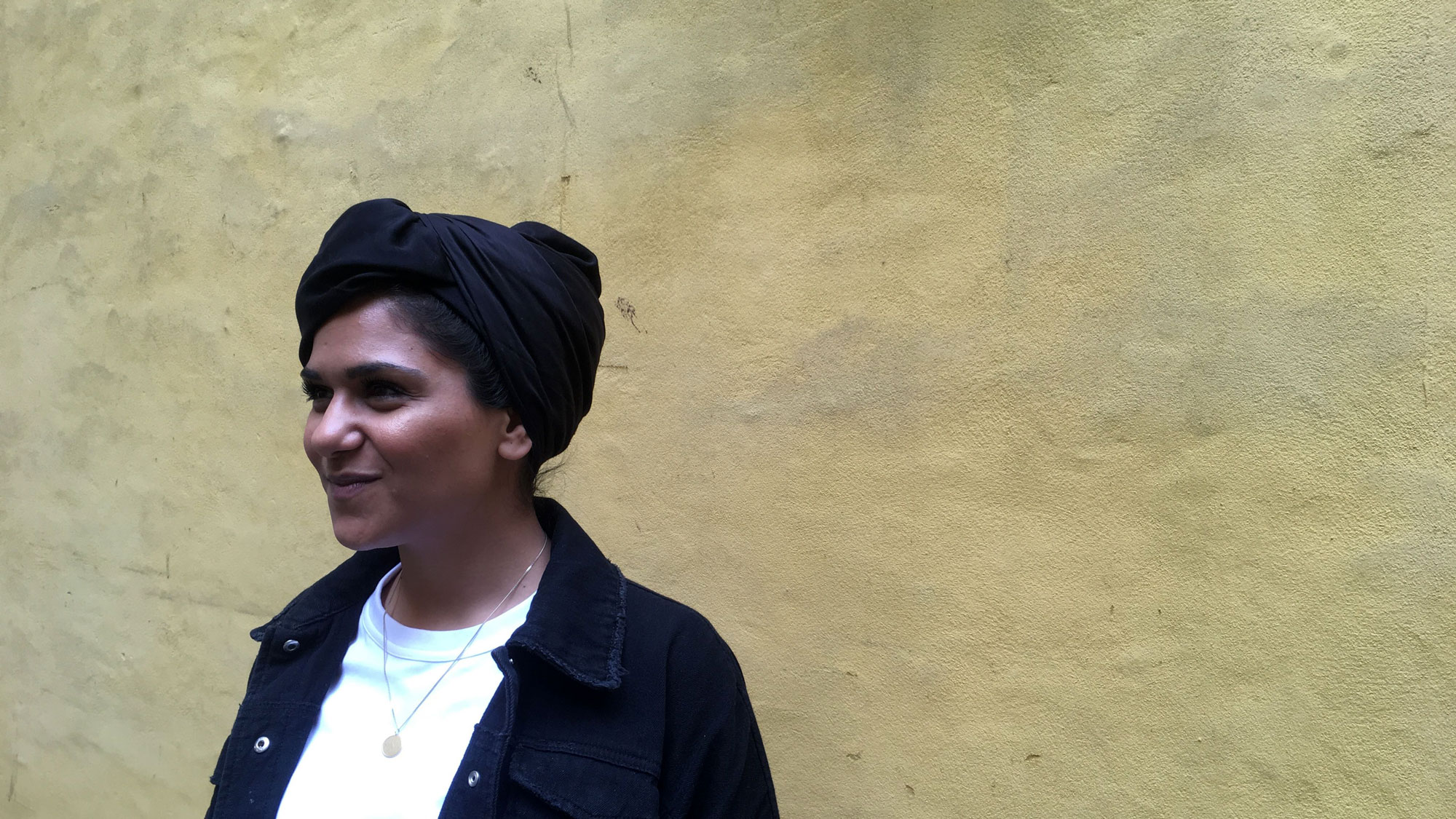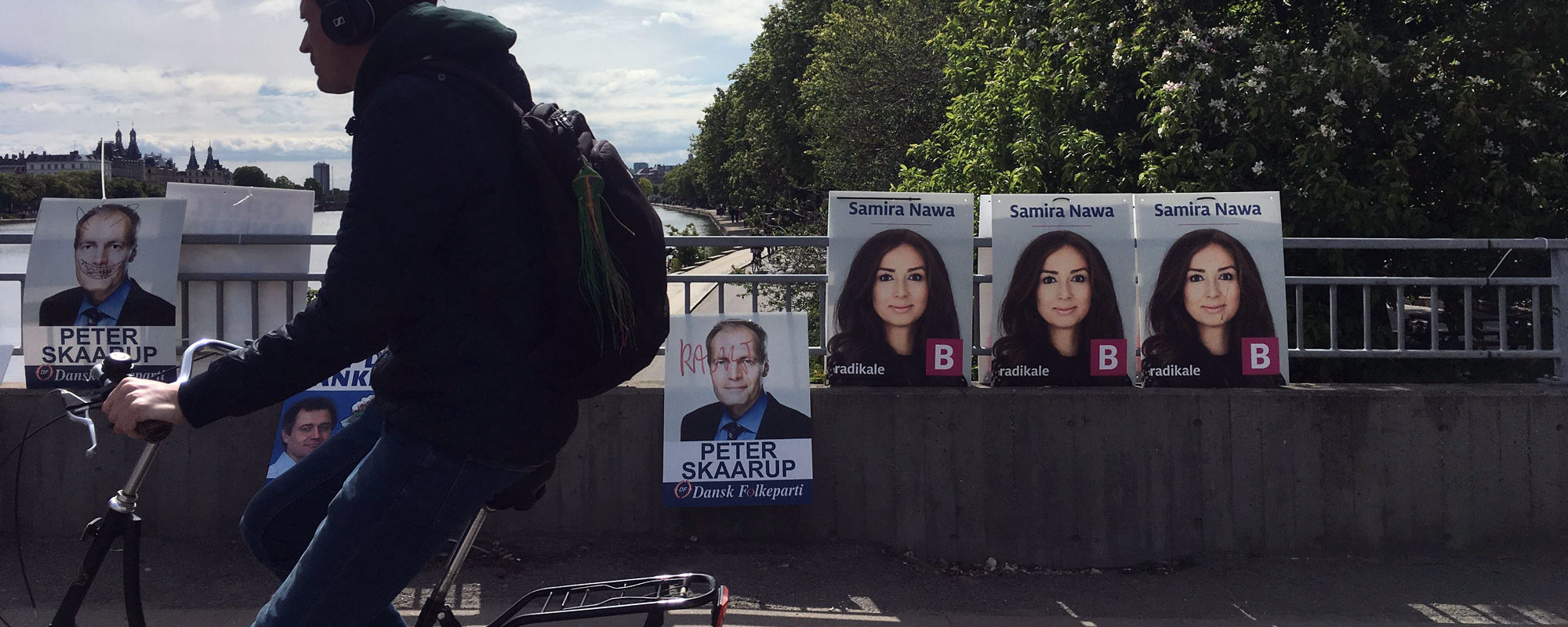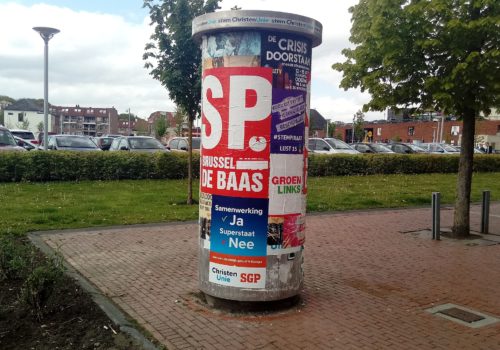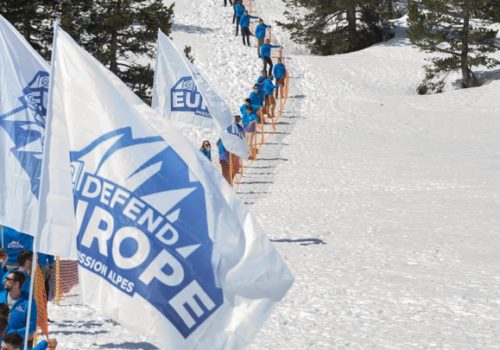COPENHAGEN — On a bright and sunny afternoon in mid-May, police blocked off Nørrebrogade, the buzzing avenue that runs through the capital’s multicultural Nørrebro neighborhood. Hours before, Rasmus Paludan, an anti-Muslim provocateur who recently entered the political scene, had announced on Facebook that he would be organizing a campaign rally ahead of legislative elections on June 5.
Paludan defends an extremist platform that includes ridding Denmark of its Muslims, an estimated 7 percent of the population. He’s become infamous for his offensive and outlandish antics—he routinely burns the Quran or stuffs it with bacon—and has organized such rallies for the past year, often opting for areas like Nørrebro that are home to large immigrant populations.
In April, violence erupted in Nørrebro after Paludan threw the Quran in the air and watched it hit the ground. Angry protesters tried to push past his police security detail and riots broke out, with locals setting fire to garbage cans and cars. The incident led to some 23 arrests and was broadcast on national television.
Before the April riot, Paludan—a lawyer whose small, far-right Stram Kurs party, or Hard Line, existed primarily on YouTube, with teenagers as its prime audience—had managed to garner only 5,000 of the 20,000 signatures necessary to present his candidacy for next week’s parliamentary elections. But in the two weeks that followed the incident, his support skyrocketed. He managed to get the necessary 20,000 signatures seemingly overnight.
Polls from early May indicate Paludan’s Hard Line could win enough votes to enter parliament, although his numbers have trailed more recently. At best, one poll indicated that he could take just two or three of the 179 seats in Denmark’s legislature. Even more recent numbers show him hovering just above the necessary threshold to enter parliament. But in the lead-up to the June vote, he’s all anyone can talk about.

For many Danes, Paludan’s startling emergence is the worst-case outcome of an ongoing rightward shift in their country’s politics, particularly pertaining to immigration and Islam, that has left its trace across the political spectrum.
The slide began in the late 1990s and was consecrated in the 2001 election—the first vote since 1924 in which the left-leaning Social Democrats failed to win a plurality of seats in the parliament. Instead, the government veered to the right, as the center-right Venstre party outperformed the left and the far-right Danish People’s Party won more votes than ever before.
That configuration has since laid the blueprint for the country’s politics, reaching new heights amid the 2015 migrant crisis and rise of Islamist terrorism in Europe, from which Denmark wasn’t spared. A hard line on immigration has anchored the political debate, pulling the Social Democrats along with it. As a party legislator told the BBC, “If you’re not a party that gives sufficient answers to the new immigration issues, to all discussions about multiculturalism… you are going to lose out.”
Now polls show the Social Democrat politician Mette Frederiksen in the lead to be the next prime minister, with the party’s legislators likely winning a plurality of seats. The Danish People’s Party, which had won an unprecedented number of seats in the 2015 vote, is set to win just half as many this year. But the Social Democrats’ renewed success provides little comfort to those Danes who fear that xenophobic rhetoric has become the rule, and not the exception, of contemporary politics.
Governing in the “ghettos”
I met Sabah Qarasnane in Tingbjerg, a 30-minute bus ride from Nørrebro. She was warm and vibrant when she greeted me outside the library of this social-housing block, recently remodeled and equipped with computer stations and reading nooks. It’s a far cry from the low-income high-rises I’ve seen tower over the Paris banlieues, defined more than anything by the absence of public resources. Even in its roughest corners, Denmark’s welfare state is visible.
Qarasnane, 47, immigrated to Denmark from Morocco 20 years ago and has Danish citizenship. But for the past year, she told me, it’s difficult to see herself as a full citizen. “I’m no longer equal before the law,” she said.
She was referring to a controversial policy the government passed last year dubbed the “ghetto package”: a new set of laws aimed at improving integration and reducing crime in 25 low-income areas categorized as “ghettos,” based on a list the government introduced in 2010. The authorities officially define “ghettos” as areas where “the proportion of immigrants and descendants from non-Western countries exceeds 50 percent”; they must also meet two of four criteria: high unemployment, a crime rate three times the national average, basic education levels and low incomes.

The ghetto package partly focuses on promoting more diversity: Certain social-housing blocks will be demolished and replaced with more mixed units (Social Democrats I interviewed said new low-income units would be built elsewhere, replacing those razed). But the policy carried a spate of more sinister provisions that many perceived as discriminatory.
One measure doubles punishments for crimes committed in these areas; another requires “ghetto children” from age 1 to attend mandatory courses in Danish values and traditions, including Christmas and Easter, as well as language courses. Noncomplying families risk being stripped of government benefits. While the general population also sends its children to preschools, those families are free to choose whether or not to enroll them until age six.
The language accompanying the rollout sounded alarm bells among ethnic minorities and antiracism activists. In one striking example, the prime minister, from the Venstre party, said ghettos could “reach out their tentacles onto the streets,” and have created “holes in the map of Denmark.”
The far-right Danish People’s Party introduced the laws, but the measures earned overwhelming support across the spectrum, including from the Social Democrats. Some even harsher proposals, such as imposing curfews on “ghetto children” after 8 p.m. and increasing surveillance on “ghetto families” were ultimately excluded from the package.
For Qarasnane, the laws are not just stigmatizing but also ineffective. “They target young people and punish families, but the kids will become integrated anyway—if they go to school at age 1 or age 5,” she said. Imposing double sentences on youth who commit petty crimes, she said, will only alienate them. “It’s incredibly discriminatory to say that just because you live in Tingbjerg, you have to serve twice as many years in jail than if you commit the same crime in downtown Copenahgen,” she said. “I’ve seen kids thrown out of the community, thrown out of the area.” Some small crimes that normally incur small penalties have translated into jail sentences, she added.

Eighteen-year-old Barwaqo Jama Hussein, a Tingbjerg resident and Somali refugee who came to Denmark when she was five, said the package just reinforced a sense of being unwanted. “When I talk to other kids here, they see that there are separate laws for our area, that in the media and politics, people say Tingbjerg isn’t just a ghetto, it’s a bad ghetto,” she said. “All they hear is that they’re drug dealers and criminals, and that they don’t have jobs. So they start saying to themselves that maybe that’s true. Maybe I am those things.” The rhetoric, she added, has only become harsher. “I remember just a few years ago, politicians wouldn’t use the word ‘ghetto,’” given its echoes of the Second World War. “Now it’s part of the mainstream conversation.”
She doesn’t deny crime is higher in Tingbjerg than other areas, especially among young residents. “Maybe instead of making people feel like second-rate citizens, they could give us something to do,” she said, noting that there’s nowhere for young people to gather besides the library. “When teenagers stand around and linger, well, it becomes easier for people”—criminals or even Islamist extremists—“to come up to them and say, ‘hey, we have something for you.’”
Birgitte Arent Eiriksson, a lawyer at the think-tank Justitia, was an outspoken critic of the policy when it was being debated last summer. She suggested that the government had misdiagnosed the problem. “Is the issue where they come from—their origins, the fact that their families aren’t from Denmark? Or is it because they face discrimination, because they grow up with real social problems?”
By prioritizing the issue of immigration, mainstream parties only help boost the frame of the populist radical right.
That doesn’t mean there are no real challenges to address. A former policewoman, Eiriksson said that when a fire breaks out in certain areas, the fire brigade won’t even enter without police protection. “We need to find a way to address these issues while respecting the rule of law,” she said. “Denmark has always been famous for its values. The question is, what kind society we do we want to live in?”
Qarasnane agreed that many recent immigrants in areas like Tingbjerg struggle to integrate. “Tingbjerg is apart, it’s separate from Denmark,” she told me. “Some of the people here, if they leave the neighborhood, they’re totally lost. And that’s a problem. They’re closed in on themselves and they’re isolated.”
But the new policies haven’t incentivized her neighbors to integrate, she said. “There’s a war going on at the moment. There’s so much hatred.”
A cold welcome for Muslims
The “ghetto package” is just the latest example of Denmark’s increasingly harsh tone on immigration and ethnic minorities. The small Scandinavian country has faced significant demographic shifts since the 1960s, when Danish companies brought in so-called guest workers, notably from Turkey, Pakistan, Morocco and what was then Yugoslavia. When that policy ended in 1973, there were an estimated 20,000 “non-Western” immigrants residing in Denmark. By the 1980s, that number had exploded to some 200,000, transforming what had been an ethnically homogeneous state into a multiethnic society.
That new reality collided with the changing global geopolitics of the 1990s, marked in large part by the First Gulf War. By 1998, those anxieties were grafted onto the political map. The emergence of the Danish People’s Party rocked the political scene; in that year’s legislative elections, the Social Democrats won by just a small margin. “At the time, everyone was shocked,” Aydin Soei, a sociologist and author, told me over coffees at a Nørrebro café. “They said, how could a far-right party become a major player in Denmark? Since then, it’s dictated immigration policy.”
The shift deepened after September 11, he said. Concern over immigration’s potential strain on the prized Danish welfare system morphed into a more generalized anxiety about immigrants themselves, particularly Muslims. “What happened outside Denmark’s borders launched an internal conversation about Islam,” Soei said. “Suddenly, it wasn’t about immigrants—it was about Muslims being overrepresented in crime statistics, or threatening distinct national identity.” In the 2001 election, the Danish People’s Party won an unprecedented 13 seats in the parliament.
Mounting tensions came to a head in 2005, when the newspaper Jyllands-Posten published a series of cartoons that caricatured the Prophet Mohammed. Muslim Danes expressed outrage—many consider it blasphemous to depict the prophet—and the incident quickly escalated, prompting protests in Muslim countries. Some turned violent. The episode gained international significance, emblematic of the strained rapport between Islam and the West.

Since the early 2000s, Denmark has denied asylum to Muslim refugees at a rate ten times higher than non-Muslims; in 2015, it rejected Afghan and Iraqi asylum applications at a higher rate than Germany, Sweden and Norway, and its overall acceptance rate came to far below the EU average. And long before Donald Trump’s shift to “skilled immigration” began making headlines, Denmark had introduced a similar policy back in 2005—to require UN resettlement to be based on “integration potential,” which negatively affected Muslim refugees. In November 2016, the current integration minister, from the Venstre party, ended Denmark’s participation in the UN refugee resettlement program entirely.
In January 2016, parliament passed a law authorizing the authorities to seize cash and valuables from asylum-seekers. In August 2018, Denmark banned the burqa and niqab, the full-face veil worn by some 200 women across the country. That December, a new law made handshakes a mandatory requirement for citizenship, targeting Muslims who refuse to shake hands with the opposite sex based on their religious beliefs. Around the same time, the integration minister announced plans to isolate foreigners, asylum-seekers among them, who have committed crimes and served their sentences—but can’t be deported to their home countries—on far-off Lindholm Island, which currently houses a center for researching highly communicable diseases. This month, the prime minister said that Denmark should establish permanent border controls, the latest EU member to distance itself from the Schengen Zone’s prized principle of free movement within the bloc.
When the center becomes the right
Qarasnane and others I met lamented that the Social Democrats have supported many such right-wing policies. They notably backed the Danish People’s Party’s so-called paradigm shift, which redefined asylum as a mechanism for eventual repatriation rather than full integration into Danish society. “We call them the Danish People’s Party ‘lite,’” Qarasnane said. “They used to be on the left, but now I can’t tell them apart from the right.” During a week of interviews, I heard that label—“DPP-lite”—used over and over to describe the Social Democrats.
Soei echoed her sense of disillusionment. “They were the party that created the Danish welfare state,” he said. “And now it’s totally reversed course on ethnic minorities. They’ll call it a ‘politics of necessity.’ But it’s also part of a cynical political calculation,” he said. “It’s sort of a natural law in Danish politics that around elections, you turn up the heat when it comes to Islam, integration and immigration,” he said.
Rune Stubager, a professor of political science at Aarhus University, described the Social Democrats’ rightward shift as a direct response to the Danish People’s Party’s rise and the right’s appeal more generally. “The current leadership says very openly that they’ve lost nearly every election since the late 1990s because of immigration,” he told me. “They see themselves as the natural party of power, and they know that immigration is just something they’ll have to deal with in order to win.”

One Social Democrats legislator, who spoke on the condition of anonymity, expressed reservations about certain party positions, notably the ghetto package. “You can’t teach a 2-year-old about democracy and threaten family’s access to welfare benefits. It’s symbolic politics and finger-pointing,” she said. “Psychologically, it will have the opposite goal when it comes to integration. And that’s what the People’s Party wants, to alienate foreigners.”
To a certain extent, she told me, compromise is an inherent part of democratic governance. “It can have consequences. But you do it because being outside is worse than being inside—it’s better to be in the center than shout on the far right or far left.”
Still, she called the ghetto package and other recent immigration policies a “clear victory” for the Danish People’s Party. “When it comes to the Denmark’s debate on immigration, they’ve won,” she said. “In every aspect, the far right has been successful. The left has lost. The center has lost. This is true all over Europe.”
Nanna Grave Poulsen, the chairwoman of a local Social Democrats chapter and a campaign worker in the Copenhagen area, said her party’s aims have been misconstrued: “We’ve changed our immigration policies because we’ve realized that’s necessary to ensure that everyone in Denmark has a good life,” she said. That has required limiting the number of immigrants who enter the country—and ensuring that those who do come are better-integrated. “It makes me sad to hear that people are disillusioned,” she told me.
The worst-case scenario in parliament
For many Muslim Danes, the Social Democrats’—and other centrist parties’—original willingness to adopt the Danish People’s Party’s line and tighten immigration laws have made Paludan’s emergence, once unthinkable, a political reality. “It’s become ugly—it’s the first time that people feel targeted in real terms, with Paludan and his rallies,” Natasha Al-Hariri, a spunky 30-year-old lawyer and minority-rights activist, told me.
She doesn’t see Paludan in isolation. “He’s been legitimized by 20 years of talk about Muslims. He’s an extension of the Danish People’s Party. None of this existed even three years ago. When is enough enough?”
I asked her if it she thought it dangerous to focus on Paludan, a controversial but marginal figure. He might not even enter the parliament at all and, if he does, his proposals—like deporting all Muslims from Denmark—are unlikely to have any sway, even among right-wing legislators.

“Yes and no,” she said. “We can’t not talk about Nazis knocking on the parliament’s door. That’s not something you can ignore. But at the same time, people have lost focus of the parties that actually have the power.” The risk, she told me, is that the Danish People’s Party is starting to look moderate That’s because relative to the likes of Paludan, the traditional far right—which is anti-refugee and against the European Union, but speaks with the poise of a mainstream party—“actually is kind of moderate,” she said. She scrunched her nose and shook her head when she said this. “Never mind.” She lit a cigarette. “I’m not going to sit here and defend the Danish People’s Party. They’re still racists. They’re still Islamophobes. But it would be incorrect to say they’re not part of the political establishment today.”
Another Muslim Dane I spoke to, who preferred to be identified only by his first name, Shahid, said Paludan’s electoral performance is beside the point. “He’s reaching every home in Denmark, on prime-time television,” he said. “My kids are asking me if they’re going to be kicked out of the country.” He and his wife have talked about leaving Denmark entirely. “Even without political strength, he’s had enough exposure to make people feel unsafe, to make them feel insecure about their future. He has the platform, the cameras are on him. He’s already won.”
Copying the far right to save the left
The rightward shift of Denmark’s Social Democrats—and the way it’s entangled with the rise of extremist figures—is hardly isolated. As far-right populists maintain momentum across Europe, center-left parties from France to Germany have struggled to hedge against their appeal. In France, for example, it is Emmanuel Macron’s En Marche party, rather than the traditional left—the once-dominant Socialist Party has faded to near insignificance, earning just 6 percent of votes in the European Parliament elections—that has shifted rightward on immigration and identity amid an ascendant far-right National Rally.
Still, the parallels with Denmark and other EU countries are difficult to miss: A party that once defended progressive values has flirted with hard-line, nationalist rhetoric in order to stave off a far-right victory. And it’s unclear if that’s been an effective strategy: the National Rally outperformed En Marche in the European Parliament elections.
The center-left’s decline began across Europe in the early 2000s, but as Cas Mudde, an expert on populism at the University of Georgia, has explained, the so-called migrant crisis of 2015 led those parties to take a harder line on immigration and asylum. That has fueled an assumption that center-left parties must adopt right-wing rhetoric lest they vanish from the political scene altogether. But the tactic backfired, according to Mudde: “By prioritizing immigration as an issue—and reinforcing the negative depiction of migrants and migration—mainstream parties only help boost the main issue and frame of the populist radical right.”

But if Denmark’s Social Democrats are set to outperform the Danish People’s Party in next week’s elections, does that mean their strategy—to parrot the far-right on immigration—has worked?
According to Stubager, the political scientist, the Danish People’s Party’s decline goes beyond the Social Democrats’ right turn. “They had such a good election in 2015 that it was almost inevitable that they’d lose some of that,” he said. Their votes have also been scattered by the emergence of Paludan’s Hard Line and another extremist party, the New Right. But perhaps the most significant blow to their success was a corruption scandal that dates back to 2016, in which the party was accused of misusing EU funds. “That scandal is still unresolved, and it hit them immediately,” Stubager said. “That’s support they still haven’t been able to recover.” The party’s waning popularity, then, has less to do with the electorate’s moderating views and more with its own political missteps.
With the polls overwhelmingly indicating that the Social Democrats will return to power, will the party soften its tone on immigration? “The big test, of course, will be how they behave after the election,” Stubager said. If they keep their hard line, “they’ll have trouble gaining support from the left-leaning and social-liberal parties that would normally support them.”
I asked Poulsen, the party’s local chairwoman, if there were any plans to shift course. “Right now, we’re being very firm,” she told me. “We don’t want to lose the voters we’ve managed to take away from the right.”




